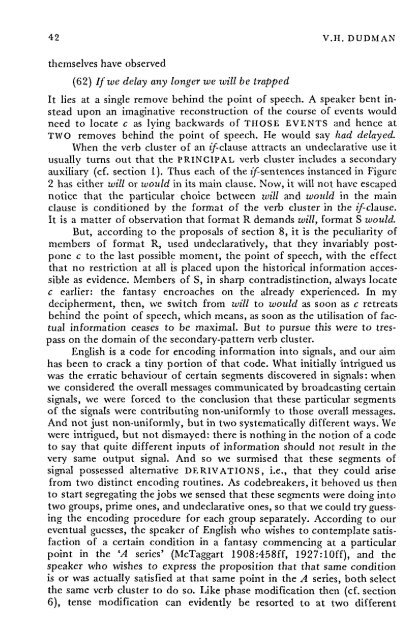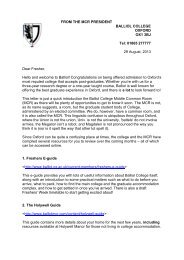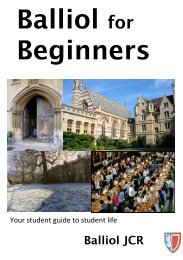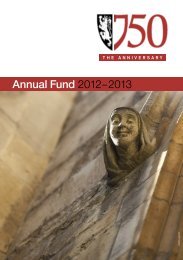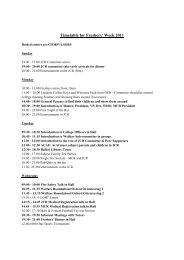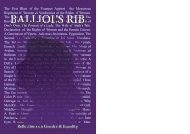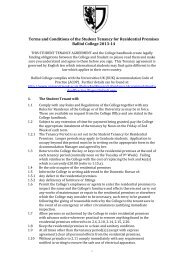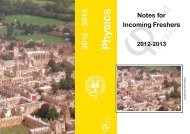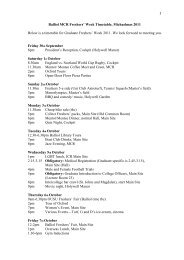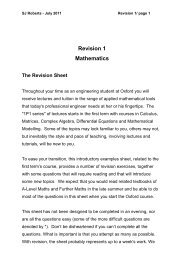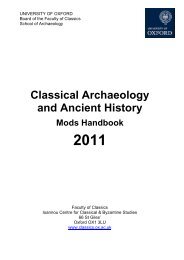TENSE AND TIME IN ENGLISH VERB CLUSTERS OF THE ...
TENSE AND TIME IN ENGLISH VERB CLUSTERS OF THE ...
TENSE AND TIME IN ENGLISH VERB CLUSTERS OF THE ...
- No tags were found...
Create successful ePaper yourself
Turn your PDF publications into a flip-book with our unique Google optimized e-Paper software.
42 V.H. DUDMAN<br />
themselves have observed<br />
(62) If we delay any longer we will be trapped<br />
It lies at a single remove behind the point of speech. A speaker bent instead<br />
upon an imaginative reconstruction of the course of events would<br />
need to locate c as lying backwards of THOSE EVENTS and hence at<br />
TWO removes behind the point of speech. He would say had delayed.<br />
When the verb cluster of an !/-clause attracts an undeclarative use it<br />
usually turns out that the PR<strong>IN</strong>CIPAL verb cluster includes a secondary<br />
auxiliary (cf. section 1). Thus each of the ty"-sentences instanced in Figure<br />
2 has either will or would in its main clause. Now, it will not have escaped<br />
notice that the particular choice between will and would in the main<br />
clause is conditioned by the format of the verb cluster in the z/-clause.<br />
It is a matter of observation that format R demands will, format S would.<br />
But, according to the proposals of section 8, it is the peculiarity of<br />
members of format R, used undeclaratively, that they invariably postpone<br />
c to the last possible moment, the point of speech, with the effect<br />
that no restriction at all is placed upon the historical information accessible<br />
as evidence. Members of S, in sharp contradistinction, always locate<br />
c earlier: the fantasy encroaches on the already experienced. In my<br />
decipherment, then, we switch from will to would as soon as c retreats<br />
behind the point of speech, which means, as soon as the utilisation of factual<br />
information ceases to be maximal. But to pursue this were to trespass<br />
on the domain of the secondary-pattern verb cluster.<br />
English is a code for encoding information into signals, and our aim<br />
has been to crack a tiny portion of that code. What initially intrigued us<br />
was the erratic behaviour of certain segments discovered in signals: when<br />
we considered the overall messages communicated by broadcasting certain<br />
signals, we were forced to the conclusion that these particular segments<br />
of the signals were contributing non-uniformly to those overall messages.<br />
And not just non-uniformly, but in two systematically different ways. We<br />
were intrigued, but not dismayed: there is nothing in the notion of a code<br />
to say that quite different inputs of information should not result in the<br />
very same output signal. And so we surmised that these segments of<br />
signal possessed alternative DERIVATIONS, i.e., that they could arise<br />
from two distinct encoding routines. As codebreakers, it behoved us then<br />
to start segregating the jobs we sensed that these segments were doing into<br />
two groups, prime ones, and undeclarative ones, so that we could try guessing<br />
the encoding procedure for each group separately. According to our<br />
eventual guesses, the speaker of English who wishes to contemplate satisfaction<br />
of a certain condition in a fantasy commencing at a particular<br />
point in the 'A series' (McTaggart 1908:458ff, 1927:10ff), and the<br />
speaker who wishes to express the proposition that that same condition<br />
is or was actually satisfied at that same point in the A series, both select<br />
the same verb cluster to do so. Like phase modification then (cf. section<br />
6), tense modification can evidently be resorted to at two different


